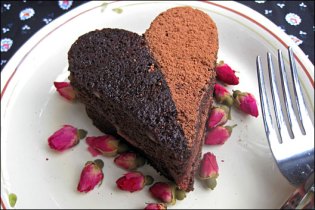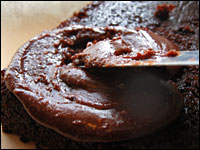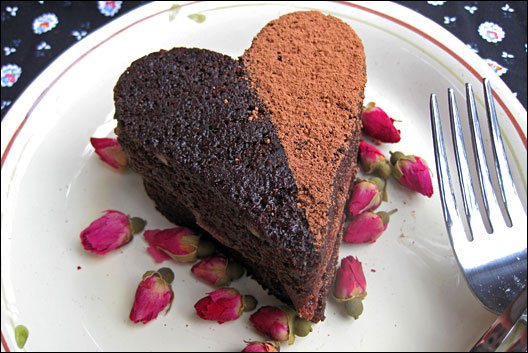 In the many years I worked in the restaurant world, Valentine’s Day meant whipping up confections for other people’s sweethearts. The pressure was steep: People scramble for reservations on the romantic holiday, and desserts are expected to impress.
In the many years I worked in the restaurant world, Valentine’s Day meant whipping up confections for other people’s sweethearts. The pressure was steep: People scramble for reservations on the romantic holiday, and desserts are expected to impress.
This year, I’ll be at home — and focusing on a Valentine’s Day sweet for my very own Valentine. I knew the dessert would have to be chocolate, and it would be a huge boon if was also dairy-free, because Phil, like millions of others, has difficulty digesting lactose. I also knew that he prefers cakes to pies, puddings, tortes, or even truffles. So I had a place to start, but there were more requirements.
I am a very picky home baker — lazy even, some might say. I bake professionally, so when I am baking for family I like to keep things simple. I don’t like to hear the noise of an electric mixer, so I prefer to stir things together by hand. I don’t want to wear my arm out beating egg whites, so I tend to choose batter cakes, which can easily be stirred together. Last, I want something relatively easy because I do not want to spend my whole day “off” on my feet in the kitchen. That’s a lot to ask of one dessert, I know.
Frosting on the Cake
I have long had a favorite vegan chocolate batter-cake recipe, so I used it as a starting place. Ten years ago it was simply my favorite easy chocolate cake, before I even noticed that the recipe was vegan. As in many American oil-based cakes, this one leans on baking soda and vinegar for leavening. The recipe is adapted from Fannie Farmer’s “Mix-in-the-Pan Chocolate Cake.” I have made it so many times, with so many different variations, that my versions barely resemble the original. But the Fanny Farmer backbone remains. To finish, I usually just give it a simple dusting of cocoa powder or powdered sugar. But Valentine’s Day was just the challenge I needed to come up with a delicious vegan chocolate frosting to make it special and new.
I generally look down my nose at most vegan desserts because they rely on soy margarine, which is a product that I prefer not to use in my cooking. I am not a fan of the taste of soy margarine or soy milk, and in general, I try to limit my intake of unfermented soy. When you eliminate soy from vegan baking, things get much more complicated. I knew that I could make a ganache glaze with chocolate and coconut milk, but I wanted a cake that was reminiscent of the soft and fluffy chocolate layer cakes of my childhood, with old-fashioned fudge frosting.
I got out my family recipe for fudge frosting, which calls for half and half and butter. I decided that I would use coconut milk in place of the half and half and would try virgin coconut oil in place of the butter. Virgin coconut oil is a product that I have been experimenting with a lot this past year, and I absolutely love the heavenly aroma it lends to baked goods.
Coconuts and Bolts
Coconut oil has begun to reenter our food system after being abandoned in the saturated-fat scare brought to us by intense lobbying from the domestic vegetable-oil industry — the same campaign that convinced millions to replace traditional fats with partially hydrogenated (and completely unhealthy) vegetable oils. Yet minimally processed tropical oils are healthful, do not contribute to heart disease, and have been used safely for thousands of years.
My first challenge was substituting coconut oil for butter in frosting. I figured I’d have to do some tweaking, because coconut fat is harder at room temperature than butter. But to my surprise, on the first try, it worked like a charm. For the coconut lover, this frosting might even be an improvement on the butter and cream version. Better still, this frosting can be easily whipped up with just a few strokes with a wooden spoon.
Once I knew that a coconut fudge frosting would work, I decided to underscore the coconut flavor in my cake as well by using virgin coconut oil and coconut water in the batter. Two other less processed ingredients that I employed in this recipe were natural, fair-trade cocoa powder and Rapadura, or evaporated cane sugar juice. I’ve struggled in the past getting Rapadura to melt the way sugar does, so I opted for organic unbleached sugar in the frosting and Rapadura in the cake. Rapadura is high in trace minerals so it has more nutritional value than sugar, but should still be used in moderation.
I used natural, Fair Trade-certified cocoa powder in both the cake and the frosting. Natural cocoa powder has a fruity and complex taste, and I prefer it to Dutch-processed or alkalinized cocoa powder. Dutch-processing of cocoa powder is used to lower bitterness, but the process isn’t necessary if the beans used in the cocoa powder are of very high quality.
Finally, because I don’t like to have a whole cake around for just my husband and me, I baked the cake in a 9 x 13-inch pan and cut it into heart shapes. I layered the heart-shaped cake with fudge frosting and dusted the top with cocoa powder. Now I can share the love with friends.
Easy, Vegan Chocolate Cake
This recipe makes one 8-inch cake, but here I’ve called for one thin 9 x 13-inch layer to be cut into heart shapes and layered. You can double this recipe for an 8-inch two-layer cake or a thicker 9 x 13-inch half sheet cake. Experienced cake decorators freeze cake layers prior to decorating them to make them sturdier and easier to handle. This trick helps when cutting the cake layer into shapes, too.
1/2 cup whole wheat flour
1 cup Rapadura or sugar
1/3 cup unsweetened natural cocoa powder
1/2 teaspoon sea salt
1 teaspoon baking soda
1 tablespoon apple cider vinegar
1 teaspoon vanilla extract
1/3 cup virgin coconut oil, melted and cooled slightly
1 cup of coconut water, or juice (or 3/4 cup water and 1/4 cup coconut milk)*
Preheat the oven to 350 degrees F.
Grease a 9 x 13-inch pan with coconut oil and line the bottom with parchment paper cut to fit the pan snugly.
Mix the dry ingredients in a large mixing bowl. In a smaller bowl, mix together the vinegar, vanilla, coconut oil, and coconut water. Pour the wet ingredients into the dry ingredients and whisk until well blended and smooth.
Pour the batter into the prepared pan and bake for about 20 minutes or until a toothpick or thin knife blade inserted into the middle of the cake comes out clean.
Cool the cake completely on a rack. Then slide a knife around the edges of the cake to loosen it from the pan. Place a half sheet pan or large rectangular cutting board on top of the cake pan. Grasp the sides firmly and quickly flip the cake out onto the board. Peel the parchment paper from the underside of the cake and place the cake in the freezer to firm up, for at least half an hour. When the cake is firm — don’t leave it in too long or it will freeze hard — cut out the cake into your desired shape. If a heart seems too ambitious, you can simply cut the cake into fourths for a four-layer square cake.
I prefer to frost only in between the layers and dust the top with cocoa powder. If you like more frosting and sweetness, the following recipe makes enough to frost the top and sides as well.
*Coconut water or juice can be purchased at most natural food stores and Latin markets, or can simply be drained out of a whole coconut.

Vegan Coconut Milk Chocolate Fudge Frosting
Make sure you have your cake layers ready to ice before beginning the frosting. It will set up very quickly. If it fully sets up before you finish icing your layers, warm it slightly in a bowl set over simmering water. You can thin it further with a few drops of coconut milk.
1 1/2 cups sugar
1/4 cup unsweetened natural cocoa powder
1/4 teaspoon sea salt
1/2 cup coconut milk
1 teaspoon vanilla extract
Melt the coconut oil in a medium heavy-bottomed saucepan. Stir in the sugar, cocoa powder, and salt.
Add the coconut milk, stir well, and bring the mixture to a boil. Adjust the heat to a steady but gentle boil and cook for 5 minutes, stirring often. The mixture should begin to thicken.
Remove from heat and stir in vanilla. Set the chocolate mixture aside to cool for about 20 minutes.
Beat the frosting until it thickens, about 20 strokes with a wooden spoon. Spread it over your cake layers.
Any leftover frosting can be poured in a pan, allowed to harden, and cut into squares like fudge.



